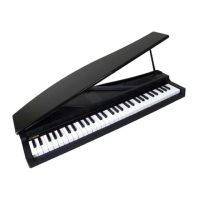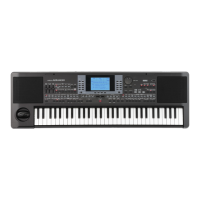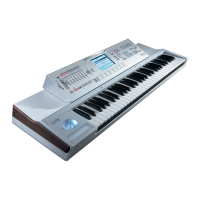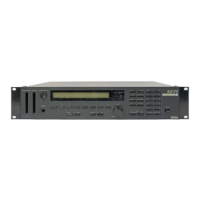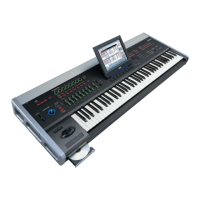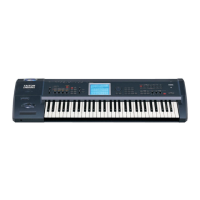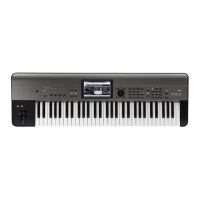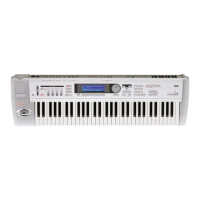105
Program operating mode
Main page
14. PROGRAM OPERATING MODE
The Programoperating mode is whereyou can lis‐
tentoindividualPrograms,andeditthem.
ToselectaProgram,seethe“Basicoperations”chapter.
In this mode, the selected Program can always be
playedacrossthefullkeyboardrange.
To automatically select the Pro
gram to be assigned
to the last selected track, keep the SHIFT button
pressed,andpressthePROGR
AMbutton.
Hint:
This is useful to see the BankSelect/ProgramChange
numberswhenprogrammingaSongonanexternalsequencer.
Note:TheProgramusesthesameScaleofthelatestselected
PerformanceorSTS.
MAIN PAGE
HereisthemainpageoftheProgramoperatingmode.
Program icon
Whenturnedon,thisiconshowsthatthe instrumentis
inProgrammode.
Page header
This line shows the selected Program name. Use the
TEMPO/VALUEcontrols,orthePROGRAM/PERFOR‐
MANCE sectiontoselectaProgram. (S
ee “Selectinga
Program”onpage25formoreinformation).
Tempo
ThisisthetempoofSequencer1.TheTempoisoneof
the AMSs (see “A M S (Alternate Modulation Source)
list”on
page123).UsetheSHIFT+DIALcombination
tochangeit.
A (Group)
This non‐editable parameter shows which group the
Programisincludedinto.Agroupistheequivalentofa
PROGRAM/PERFORMANCE button.
B (CC00)
This non‐editable parameter shows the value of the
ControlChange(CC)00message(orBankSelectMSB)
fortheselectedProgram.
C (CC32)
This non‐editable parameter shows the value of the
Control Change (CC) 32 message (a.k.a. Bank Select
LSB)fortheselectedProg ram.
D (PC)
This non‐editable parameter shows the value of the
Program Change (PC) message for the selected Pro‐
gram.Va
luesare inthestandard0–127MIDInumber‐
ingformat.
Note:Somemanu
facturerscouldusethe1–
128numbering
system; when connecting your microARRANGER to an
instrumentofthiskind,incrementthePCvalueby1unit.
Effects
In Program mode, the Program uses its own effects
insteadofrelyingonA–Deffects.Twoeffectprocessors
(FX1andFX2)areavailable.
The MIDI channel
In Program mode, microARRANGER receives and
transmitsonthesamechannelof theUpper1track.If
the Global channel is assigned, notes can be received
alsoonthischannel.See“Page6‐
MIDIINChannels”
on page127 and “Pag
e 10‐MIDI OUT Channels” on
page129formoreinformation.
SOUND PROGRAMS AND DRUM PROGRAMS
microARRANGERfeaturestwodifferentkindsofPro‐
grams:
• Sound Programs. These are normal instru
ment
Programs,likepianos,strings,basses.
•Drum Programs. These are drum and percussion
ki
ts,whereeachnoteofthekeyboardisadifferent
percussive instrument. You can find Drum Pro‐
gramsintheDRUMKITan
dUSERDKbanks.
Before pressing MENU to en
ter the edit environment,
you should sel
ect a Program of the type you wish to
editorcreate.
Notes pointing to special Drum Program featur
es are
markedbythe icon.
MENU
WhileinanyotherpageoftheProgramoperativemode,
pressMENUtoopentheProgrameditmenu.Thismenu
givesaccesstothevariousProgrameditsections.
When in the menu, select an edit section using the
VOLUME/VALUE (A–G) buttons, select an edit page
usingPAGE+,orpressEXITtoexitthemenu.
When in an edit page, press EXIT to go back to the
mainpageoftheProgramoperatingmode.
Eachit
eminthismenucorrespondstoaneditsection.
Eacheditsectiongroupsva
riouseditpages.
Program icon
Page header
Tempo
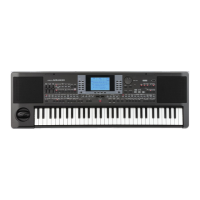
